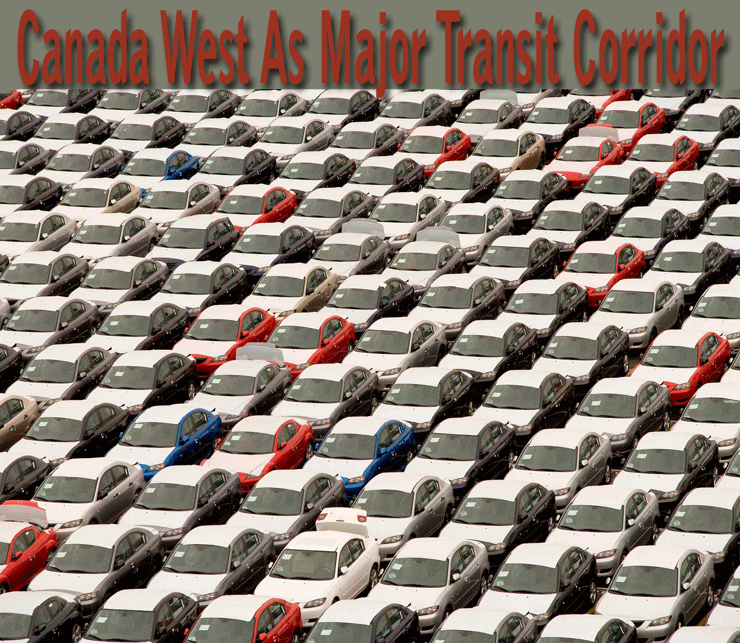
 British
Columbia is attempting to build what it calls "North America's most
competitive and efficient transportation system". Through the Pacific
Gateway Program, the national government and industry are building reliable
transportation networks and supply chains from the Pacific coast across
North America. British
Columbia is attempting to build what it calls "North America's most
competitive and efficient transportation system". Through the Pacific
Gateway Program, the national government and industry are building reliable
transportation networks and supply chains from the Pacific coast across
North America.
Pacific Gateway partners have taken concrete
action to increase the reliability of the Pacific Gateway supply chain.
BC’s ports and railways are setting
performance commitments. For example, Port Metro Vancouver, together with
railway and terminal operators, has instituted performance standards covering
container stays, weather related or operational backlogs, and a strategic
reserve of railcars.
The Prince Rupert Port Authority and Maher
Terminals have also instituted performance standards that include having
import containers loaded and moving within 3.5 days.
Recently concluded labor agreements were
designed to ensure a high level of labor stability at Pacific Gateway
ports, railways and throughout the supply chain through 2010.
Pacific Gateway government and industry
partners are implementing programs to help ensure current and future labor
needs will be met, including:
•
New apprentice and training programs
•
Immigration policies that attract skilled workers
•
More effectively targeted foreign worker programs.
The national Government of Canada and the
Government of BC are committed to keeping goods moving and have quickly
ended past labor disruptions.
In addition to port, rail, road and infrastructure
expansion to increase capacity, other efficiency measures to reduce bottlenecks
and congestion, and enhance competitiveness include:
•
Efforts to develop smart systems that reduce commercial
vehicle stops at weigh-in stations.
•
A Government of Canada commitment of over C$430 million
to more efficient border crossings, as well as increasing the number of
border security and marine ports officers.
•
An increase in truck gate hours at major ports.
•
A well-established supply chain serving Asia and Vancouver
and beyond to all major Canadian and U.S. economic centres.
Port Metro Vancouver is Canada’s largest,
with 28 major marine cargo terminals and numerous bulk and break-bulk
shipping lines and agents in addition to a diverse mix of distribution,
warehousing, consolidating and deconsolidating services.
A safe, year-round, all-weather, naturally
deep harbor on Canada’s Pacific coast, Vancouver is just north of
the U.S. border, and connected to an extensive network of roadways, three
transcontinental railways, and border crossings.
Port Metro Vancouver ranks first in North
America in foreign export shipments, and second on the west coast of the
Americas in total cargo volume. In 2008, Vancouver handled over 115 million
tons of cargo, including 2.5 million TEUs. The port reportedly moved 120
million tons of total cargo in 2009.
China is the Port Metro Vancouver’s
top trading partner for import tonnage, while Japan is the leading trading
partner in terms of exports and total throughput tonnage.
In January 2008, the Vancouver, Fraser,
and North Fraser ports amalgamated to optimize service and efficiency
at all deep-sea and river-based port facilities. Now with a broader scope,
Port Metro Vancouver is in an even stronger position to serve as a world-class
gateway.
Public and private sector infrastructure
investments totalling C$4.2 billion will increase the shipping capacity
of the Port Metro Vancouver to six million TEUs by 2020.
A C$400 million third berth at the Deltaport
facilities, located atRoberts Bank, 35 kilometres south of Vancouver's
inner harbour, is operational since fall 2009.
A second container terminal at Roberts Bank,
adding a new three-berth facility, is currently in procurement.
To accommodate this increased container
and bulk traffic, extensive road and rail improvements totalling C$10.7
billion will reduce congestion, eliminate bottlenecks and add critical
capacity.
Vancouver and Prince Rupert are the closest
North American ports to Asia Pacific They are ice-free year-round. Prince
Rupert is less than 100 hours from Chicago and has the shortest direct
rail route to the United States' large midwest and eastern consumer markets.
 According
to one key customer, Dave Bedwell (Executive Vice President of COSCO),
"Prince Rupert has become a great success story for a variety of
reasons, reasons that may not ever be accomplished by the more already
established container ports and terminals. Probably the one most significant
reason has been the collective banding of the local business community.
From the Mayor of Prince Rupert, the Chief(s) of the first nations, right
down to the local corner store owner, the support of the communities new
life line has 100% buy in. Small communities always seem to be able to
accomplish feats that larger city dwelling container terminals and ports
cannot. The port itself offers a deep water safe harbor that allows easy
access for container vessels to safely berth with high energy longshore
labor working container vessels at warp breaking productivity levels.
CN rails commitment to provide consistent and timely rail service has
been as advertised. Rail cars anxiously await containers and are immediately
expedited to North American shippers’ final desired destinations.
Prince Rupert offers a consistent process that provides exactly what an
ocean carrier is looking for from their valued business partners. So,
that all said, if it is all good for the ocean carrier then how then can
it not be good for the shippers?" According
to one key customer, Dave Bedwell (Executive Vice President of COSCO),
"Prince Rupert has become a great success story for a variety of
reasons, reasons that may not ever be accomplished by the more already
established container ports and terminals. Probably the one most significant
reason has been the collective banding of the local business community.
From the Mayor of Prince Rupert, the Chief(s) of the first nations, right
down to the local corner store owner, the support of the communities new
life line has 100% buy in. Small communities always seem to be able to
accomplish feats that larger city dwelling container terminals and ports
cannot. The port itself offers a deep water safe harbor that allows easy
access for container vessels to safely berth with high energy longshore
labor working container vessels at warp breaking productivity levels.
CN rails commitment to provide consistent and timely rail service has
been as advertised. Rail cars anxiously await containers and are immediately
expedited to North American shippers’ final desired destinations.
Prince Rupert offers a consistent process that provides exactly what an
ocean carrier is looking for from their valued business partners. So,
that all said, if it is all good for the ocean carrier then how then can
it not be good for the shippers?"
The new state-of-the-art container port
at Prince Rupert is opening up a world of opportunities. Building on Prince
Rupert’s natural advantages including its deep harbor, strategic
location of up to 2 days sailingtime closer to Asia, and superior transportation
connections into major North American markets, Prince Rupert is poised
to become the new express route between Asia and North America.
The new facility will help to reduce congestion
at existing West Coast ports and create major economic opportunities for
Canada. The new container terminal will have an annual capacity of 500,000
TEUs and be capable of handling the largest container ships of tomorrow.
Future plans feature the expansion of the terminal to reach an annual
capacity of 2 million TEUs.
The new C$170 million Prince Rupert Container
Terminal Phase 1, with a capacity of 500,000 TEUs, offers Asian
shippers a timely, direct, congestion-free corridor to Chicago and other
major American and Canadian markets.
The Port of Prince Rupert’s proximity
to Asia, with the second deepest natural harbor in the world, and direct
CN Rail connections to Chicago, allows a container shipped from Asia via
Prince Rupert to arrive in Chicago at the same time it would be leaving
LA/Long Beach for Chicago.
CN trains leaving Prince Rupert provide
fifth morning availability of containers in Chicago and sixth morning
availability in Memphis performance that’s unparalleled
in North America.
Phase 2 of the Prince Rupert Container Terminal,
with an additional capacity of 1.5 million TEUs, is projected to open
in million. Terminal 2, with a capacity of an additional two million TEUs,
is expected to be completed by 2020.
Prince Rupert also offers logistics services,
including warehousing, container stuffing and reloading and short-sea
shipping services fully integrated into primary terminal operations
to ensure continued velocity, dependability and flexibility for shippers.
To further increase reliability and efficiency,
CN has made significant investments in the Northern Corridor rail line,
including extended sidings, upgrades to signal systems and increased bridge
and tunnel clearances to accommodate double-stack container cars.
Prince Rupert is not just adding capacity;
it is also offering a new way of connecting Asia to North America.
CN has established a grain transload operation
in Chicago, permitting efficient containerization of grains for export,
in otherwise empty containers, to overseas markets. The new C$6 million
Chicago terminal augments a C$20 million BC forest products intermodal
terminal/distribution center in Prince George and a C$4 million Alberta
grain transload terminal new facilities to prepare container loads
for Asian markets.
In addition to containers of cotton, agricultural
products and other merchandise from the U.S. Midwest, Prince Rupert can
ship seafood from BC and Alaska, aluminum and forest products from Northern
BC and Alberta, and specialty agricultural products from Canada’s
four western provinces.
ROAD: An all-weather highway network
makes transporting goods to and from North American cities reliable. Road
investments totalling C$7.1 billion will reduce congestion and ensure
the efficient flow of goods to and along Canada’s transcontinental
highway, down to the U.S. border, and throughout the Vancouver area. This
includes a C$307 million investment to reduce road traffic congestion
along a key rail corridor, including nine road/rail separations, traffic
management measures and rail infrastructure improvements.
RAIL: Canada's transcontinental railways
serve ports on the Atlantic, Pacific and Gulf coasts. They also link with
U.S. and Mexican rail systems. Canadian Pacific Railway, CN and BNSF are
investing billions of dollars in major capacity and efficiency upgrades
near Vancouver and along their routes to North American destinations.
In addition, innovative operational agreements have been reached between
Canadian Pacific Railway and CN and between CN and BNSF to maximize capacity
using existing infrastructure in and near Vancouver.
AIR: Vancouver International Airport
(YVR) is a major air cargo airport and the second largest international
passenger airport on North America's West Coast.
Vancouver International Airport has frequent
and convenient connecting flights to major centers in Asia and all across
North America. A C$1.4 billion airport expansion program is underway to
add capacity for five million new passengers, for a projected total of
28.4 million passengers by 2020. Four new gates in the international terminal
building are now open. Expansion plans call for the construction of a
new international building with up to 25 gates. A new C$1.9 billion rapid
public transit line connecting the airport to Vancouver and the Lower
Mainland opened in August 2009.
In December 2006, Canada declared its intention
to pursue bilateral open skies agreements granting liberal access to carriers
of both nations serving the other internationally.
In 2009, Canada’s first open skies
agreement with an Asian nation was concluded with the Republic of Korea.
In 2010, the national Government of Canada is pursuing liberalized bilateral
air agreements withAsia-Pacific nations to encourage competition, increase
capacity, and allow for more efficient and flexible flight agreements.
Gordon Feller
|



